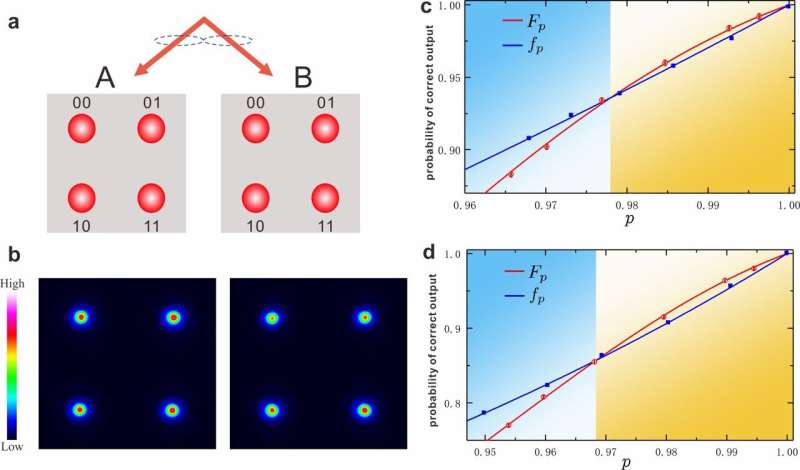a: Principle to implement physical qubits with the spatial modes of two entangled photons. And the experimental pattern on each photon is illustrated in b. Experimental results of the fault-tolerant circuits for the logical operation of single-qubit Hadamard gate are shown in c, and the results for the logical operations considering a following two-qubit controlled-not gate are shown in d. Fp and fp represents the success output probabilities for the encoded circuit and non-encoded circuit, respectively. The fault-tolerant manner is verified with Fp > fp. Credit: Kai Sun et al.
Dealing with experimental errors, which could occur in every step of quantum circuits, is of great importance, especially in the implementation of quantum computation. Generally speaking, quantum error correction requires more qubits to accomplish the correction operation.
However, the fault-tolerant method, in which logical qubits are encoded with several physical qubits and the error in the physical space is allowable and is not expected to be corrected, provides another way to treat the error by excluding the qubit with errors from the encoded space.
To be more precise, based on the same hardware, logical qubits could be out put with a better probability in the fault-tolerant encoded circuit than that in the non-encoded circuit when the error rate is below the threshold. More importantly, the fault-tolerant circuit could be verified in a small system consisting of several qubits. And the threshold—explicit evidence to support the success of fault-tolerant method—could be determined when comparing the output probabilities of encoded circuits and non-encoded circuits.
In a new paper published in Light Science & Application, a team of scientists, led by Professor Chuan-Feng Li from CAS Key Laboratory of Quantum Information, University of Science and Technology of China, have exploited the spatial modes of two entangled photons to construct an experimental platform and have directly observed the fault-tolerant threshold for the investigated quantum circuits.
With the physical qubits represented by coincident counts of the spatial modes of each photon, two logical qubits are encoded and manipulated through the corresponding operations on the physical qubits. Importing the error rate artificially with an extremely high accuracy, we could scan the range of error rate which covers the threshold. When the success output probability of the encoded circuit is higher than that of the non-encoded circuit, we can confirm the exact value of the threshold, which is supported by the strong results including the single-qubit and two-qubit operations in the logical space.
Besides facilitating the investigation of fault-tolerant quantum computation in scalable systems, this work is helpful for other quantum information tasks, such as entanglement purification and long-distance quantum communication.
By observing the error rate threshold, we could understand the detail framework of fault-tolerant protocols and judge the success of fault-tolerant. The scientists summarize the performance of optical platform:
"We construct the setup based on the spatial modes of two photons which manifests the following advantages: (1) high-accuracy operation which is the rigid requirement of fault-tolerant circuit; (2) easy to import the artificial error and adjust its rate; (3) present the straight pattern of every step in the fault-tolerant process; and (4) easy to implement the fault-tolerant encoded circuit and non-encoded circuit."
"Besides the error type considered in this work, other error models in a universal fault-tolerant protocol could be investigated based on this experimental platform. For example, with extending the experimental platform based on the optical spatial mode from single-photon framework to two-entangled-photon framework in this work, the nonlocal error effect could be further investigated in the fault-tolerant quantum computation," the scientists say.
More information: Kai Sun et al, Optical demonstration of quantum fault-tolerant threshold, Light: Science & Applications (2022). DOI: 10.1038/s41377-022-00891-9
Journal information: Light: Science & Applications
Provided by Chinese Academy of Sciences
























